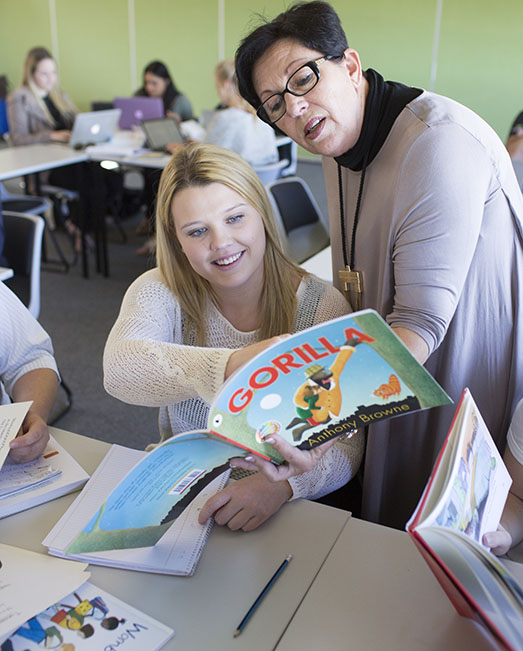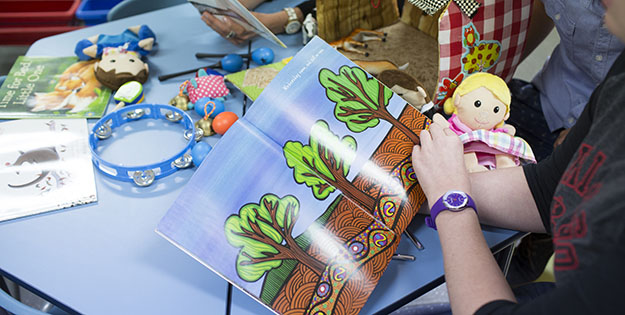Global
Copyright@ Australian Catholic University 1998-2026 | ABN 15 050 192 660 CRICOS registered provider: 00004G | PRV12008
Copyright@ Australian Catholic University 1998-2026 | ABN 15 050 192 660 CRICOS registered provider: 00004G | PRV12008

What makes a good children’s book?
Ask a child this and they might say a book that makes you laugh, one with animals or nice pictures in it. They are unlikely to say that a good children’s book is one about mathematics.
Research tells us that children’s literature is critical in their development, boosting vocabulary and fostering a lifelong love of reading. It is less common, however, to hear of research describing the benefits of learning mathematics through picture books.
After all, what do funny stories about giraffes or shrinking parents have to do with numeracy?
In fact, the idea that children can explore mathematical concepts while they enjoy storybooks is not new, says educator and researcher Tracey Muir, Professor in Education (STEM) at ACU.
“The notion of using children’s literature, and particularly picture books, to enhance the teaching of mathematics is very well established,” says Professor Muir, who has herself engaged in research on the topic for more than a decade.
“The nice thing about using children’s books – and I’m talking about books that aren’t necessarily intended to have maths in them – is that most people love a good story, and children love picture books, and that makes it a non-threatening environment and a context they can relate to. So you have a book that is written to entertain, and you can extract the maths out of it and motivate children to explore mathematical ideas in that familiar context.”
In recent decades, pedagogical research has clearly established that children’s literature has the potential to help students to investigate mathematical concepts and develop complex skills. Some research even suggests that engaging with maths through story and picture books can improve the retention and recall of the knowledge learned, with cognitive scientists referring to storytelling as “the most natural package of organised knowledge in the cognitive system for acquiring and retaining information”.
Professor Muir’s work in the area has focused on enabling educators to see the usefulness of picture books as a teaching approach in maths lessons. While there is a substantial body of research espousing the benefits of integrating children’s literature with mathematics, the integration has not been widely enacted in classrooms.
“I think it’s happening, but it’s happening in pockets – there definitely hasn’t been widespread adoption,” she says. “The main barriers to integrating maths in classrooms have to do with resourcing, because teachers are busy people and they don’t always have time to examine a book in detail and go, ‘Okay, that one would be suitable for developing a particular mathematics concept, such as probability’.”
There’s also a broad misconception that using children’s literature for maths learning is only suitable for younger children, says Professor Muir. As students move into later primary and secondary school, maths learning tends to become more formalised and geared towards assessment, reporting and curriculum.
“So the teacher might think, ‘Oh, that’s a nice idea and that’s a lovely book’, but there are all these competing things, and if the teacher doesn’t fully realise the potential for using books to explore important mathematical concepts, it becomes more of an add-on than an integral part of their maths program,” says Professor Muir, who co-authored the teaching resource Engaging With Maths Through Picture Books with other experienced mathematics educators in 2017.
“That’s why I think it’s important that we give teachers the opportunity to see that potential, and to do that, you need resources that actually assist teachers in identifying the appropriate books and the mathematical concepts that are in there.”
While she is a strong advocate for using children’s literature to enhance mathematics lessons, Professor Muir points out that not all books fit the bill.
In Engaging With Maths Through Picture Books, she and her co-authors select some 20 books that are ideal for maths engagement, providing guidance around important factors to consider and illustrating how lessons can be developed.
Some of the books chosen include favourites like Diary of a Wombat, which can be used to engage students in the concepts of time, measurement and geometry, and None the Number by Oliver Jeffers, which covers algebra and critical thinking. Other titles like Shoes from Grandpa by Mem Fox and The Very Hungry Caterpillar by Eric Carle contain more complex concepts, like data handling and statistics.
Professor Muir notes that many children’s books used to stimulate maths learning are centred around number and measurement concepts, and are often targeted at younger students.
Having observed the scarcity of books that cover the concepts of chance and probability, she took things into her own hands, collaborating with illustrator PJ Reece to write her first children’s picture book, Heads or Tails, where a girl named Maggie tosses a coin to make decisions throughout her day.

While the book was written with the idea of engaging young people in rich mathematical conversations about key probability ideas, it is also intended to be a standalone story that entertains readers.
“If you think about chance and probability, there are so many misconceptions around it in our vernacular, where we say things like, ‘That is impossible!’, or ‘Oh that’s five heads in a row, the next one has to be tails’,” she says.
“I thought it’d be really nice to have a picture book that gets students talking about chance concepts that are real to them, so it engages students in the maths almost subversively because they’re so hooked in the story and the context.”
She also notes that using storybooks as a tool for maths learning requires a certain level of mathematical knowledge.
“If you are a parent and you’re reading a picture book to your child for enjoyment, you don’t want to make it a chore by inserting this agenda of a maths lesson into that process, because that would be contrived and at the end of the day, reading books should be fun,” Professor Muir says. “It also requires knowledge to recognise the maths that is in the books and to think of appropriate and effective ways to bring it out and get students to engage with it.”
One of the more popular books that is commonly used in mathematics classrooms is Counting on Frank by Rod Clement, which tells an entertaining story of a big dog named Frank and his owner, a young boy who loves to calculate facts.
Although many teachers would be familiar with the book, perhaps even reading it to their class and using it to teach maths, a closer look reveals that some of the calculations within it are erroneous.
“I enjoy dinner,” says the boy in Counting on Frank, “not because of the delicious grill Mum cooks EVERY night, or the thrilling conversation. It’s the peas. If I had accidentally knocked fifteen peas off my plate every night for the last eight years, they would now be level with the tabletop. Maybe, then, Mum would understand that her son does not like peas.”
Based on an average-size dining room and dining table, the boy in Counting on Frank would actually have to knock 256 peas off his plate every night for eight years to reach the level of the tabletop. And this isn’t the only mathematical error in the book.
Does this mean that teachers should avoid using the book in maths classrooms?
In an article published in Teaching Children Mathematics in 2013, Professor Muir and her colleagues say the answer to that is no.
While Counting on Frank does contain inaccuracies, it is still useful for maths learning, particularly for its “promotion of positive values and attitudes toward mathematics and creative intellectual endeavour”. Furthermore, the book’s mathematical flaws can be used as “valuable teaching points and areas for further investigation”.
“The main thing that is useful about books like Counting on Frank is that they’re actually written to entertain,” says Professor Muir, who lists Rosie’s Walk by Pat Hutchins, and Mr Chicken Goes to Paris by Lee Hobbs, as books in a similar vein.
“These types of books can motivate children to engage with maths by taking away some of the anxiety that is often associated with the subject, and that is hugely important. It can provide a non-threatening environment that helps to make maths a positive experience, because there aren’t many children out there who don’t love picture books.”
Tracey Muir is Professor in Education (STEM) at ACU and the author of the children’s book, Heads or Tails (available through Amazon), and the teacher resource, Engaging With Maths Through Picture Books.
Passionate about education? Explore the options.

Copyright@ Australian Catholic University 1998-2026 | ABN 15 050 192 660 CRICOS registered provider: 00004G | PRV12008